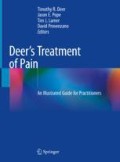Abstract
The anti-inflammatory properties of injectable corticosteroids are commonly used to treat a variety of chronic pain conditions. The primary role for the injection of corticosteroids is to reduce inflammation and pain through the localized delivery of the medication to target tissue in efforts to maximize benefit and limit systemic side effects. Spinal injections, such as epidural steroid injections (ESI), facet joint injections, and sacroiliac injections, are frequently utilized interventions to treat spine and radicular pain, while joint, muscle, and tendon sheath injections are commonly used for a variety of musculoskeletal pain conditions. Peripheral nerve blocks, utilized for perioperative anesthesia and analgesia, may include a corticosteroid component for the enhancement of neural blockade and analgesia. The appropriate utilization of injectable corticosteroids takes into consideration the aspects of safety according to site and contents of injection, as well as potential associated systemic consequences. This chapter reviews the unique set of properties of the most commonly utilized injectable corticosteroids and highlights key aspects of their use in epidural and musculoskeletal injections.
Access this chapter
Tax calculation will be finalised at checkout
Purchases are for personal use only
Recommended Reading
Bateman BT, Brenner GJ. An important step forward in the safe use of epidural steroid injections. Anesthesiology. 2015;122:964–6.
Benzon HT, et al. Comparison of the particle sizes of different steroids and the effect of dilution: a review of the relative neurotoxicities of the steroids. Anesthesiology. 2007;106(2):331–8.
Craig DB, Habib GG. Flaccid paraparesis following obstetrical epidural anesthesia: possible role of benzyl alcohol. Anesth Analg. 977(56):219–21.
Denis I, Claveau G, Filiatrault M. Randomized double-blind controlled trial comparing the effectiveness of lumbar transforaminal epidural injections of particulate and nonparticulate corticosteroids for lumbosacral radicular pain. Pain Med. 2015;16:1697–708.
Derby R, Lee SH, Date ES, Lee JH, Lee CH. Size and aggregation of corticosteroids used for epidural injections. Pain Med. 2008;9(2):227–34.
Dreyfuss P, Baker R, Bogduk N. Comparative effectiveness of cervical transforaminal injections with particulate and nonparticulate corticosteroid preparations for cervical radicular pain. Pain Med. 2006;7:237–42.
El-Yahchouchi CE, Geske J, Carter RE. The noninferiority of the nonparticulate steroid dexamethasone vs the particulate steroids betamethasone and triamcinolone in lumbar transforaminal epidural steroid injections. Pain Med. 2013;14:1650–7.
Foster Z, Voss T, Hatch J, Drimodig A. Corticosteroid injections for common musculoskeletal conditions. Am Fam Physician. 2015;92:694–9.
Freire V, Bureau NJ. Injectable corticosteroids: take precautions and use caution. Semin Musculoskelet Radiol. 2016;20:401–8.
Jüni P, Hari R, Rutjes AWS, Fischer R, Silletta MG, Reichenbach S, da Costa BR. Intra-articular corticosteroid for knee osteoarthritis. Cochrane Database Syst Rev. 2015;10:CD005328. https://doi.org/10.1002/14651858.CD005328.pub3.
Kennedy DJ, Plastaras C, Casey E. Comparative effectiveness of lumbar transforaminal epidural steroid injections with particulate versus nonparticulate corticosteroids for lumbar radicular pain due to intervertebral disc herniation: a prospective, randomized, double-blind trial. Pain Med. 2014;15:548–55.
Kim D, Brown J. Efficacy and safety of lumbar epidural dexamethasone versus methylprednisolone in the treatment of lumbar radiculopathy: a comparison of soluble versus particulate steroids. Clin J Pain. 2011;27:518–22.
Lee JW, Park KW, Chung SK. Cervical transforaminal epidural steroid injection for the management of cervical radiculopathy: a comparative study of particulate verse non-particulate steroids. Skelet Radiol. 2009;38:1077–82.
MacMahon PJ, Eustace SJ, Kavanagh EC. Injectable corticosteroid and local anesthetic preparations: a review for radiologists. Radiology. 2009;252(3):647–61.
MacMahon PJ, Huang AJ, Palmer WE. Spine injectables: what is the safest cocktail? AJR. 2016;207:526–33.
Manchikanti L. Role of neuraxial steroids in interventional pain management. Pain Physician. 2002;5:182–99.
Mehta P, Syrop I, Singh JR, Kirschner J. Systematic review of the efficacy of particulate versus nonparticulate corticosteroids in epidural injections. PMRJ. 2017;9(5):502–12. https://doi.org/10.1016/j.pmrj.2016.11.008.
Park CH, Lee SH, Kim B. Comparison of the effectiveness of lumbar transforaminal epidural injection with particulate and nonparticulate corticosteroids in lumbar radiating pain. Pain Med. 2010;11:1654–8.
Pinto RZ, Maher CG, Ferreira ML, et al. Epidural corticosteroid injections in the management of sciatica: a systematic review and meta-analysis. Ann Intern Med. 2012;157(12):865–77.
Rincon I, Battafarano D, Restrepo J, Erikson J, Escalante A. Glucocorticoid dose thresholds associated with all-cause and cardiovascular mortality in rheumatoid arthritis. Arthritis Rheumatol. 2014;66:264–72.
Shakir A, Ma V, Mehta B. Comparison of pain score reduction using triamcinolone vs. dexamethasone in cervical transforaminal epidural steroid injections. Am J Phys Med Rehabil. 2013;92:768–75.
Shamliyan TA, Bart Staal J, Goldmann D, Sands-Lincoln M. Epidural steroid injections for radicular lumbosacral pain: a systematic review. Phys Med Rehabil Clin N Am. 2014;25:471–89.
U.S. Food and Drug Administration (FDA). FDA drug safety communication: FDA requires label changes to warn of rare but serious neurologic problems after epidural corticosteroid injections for pain. FDA Website. www.fda.gov/Drugs/DrugSafety/ucm394280.htm. Published April 23, 2014. Accessed 13 May 2016.
Author information
Authors and Affiliations
Corresponding author
Editor information
Editors and Affiliations
Rights and permissions
Copyright information
© 2019 Springer Nature Switzerland AG
About this chapter
Cite this chapter
Padalia, D., Shah, N., Singh, J., Jassal, N., Reeves, C., Brewer, R.P. (2019). Injectable Corticosteroids. In: Deer, T., Pope, J., Lamer, T., Provenzano, D. (eds) Deer's Treatment of Pain. Springer, Cham. https://doi.org/10.1007/978-3-030-12281-2_26
Download citation
DOI: https://doi.org/10.1007/978-3-030-12281-2_26
Published:
Publisher Name: Springer, Cham
Print ISBN: 978-3-030-12280-5
Online ISBN: 978-3-030-12281-2
eBook Packages: MedicineMedicine (R0)

